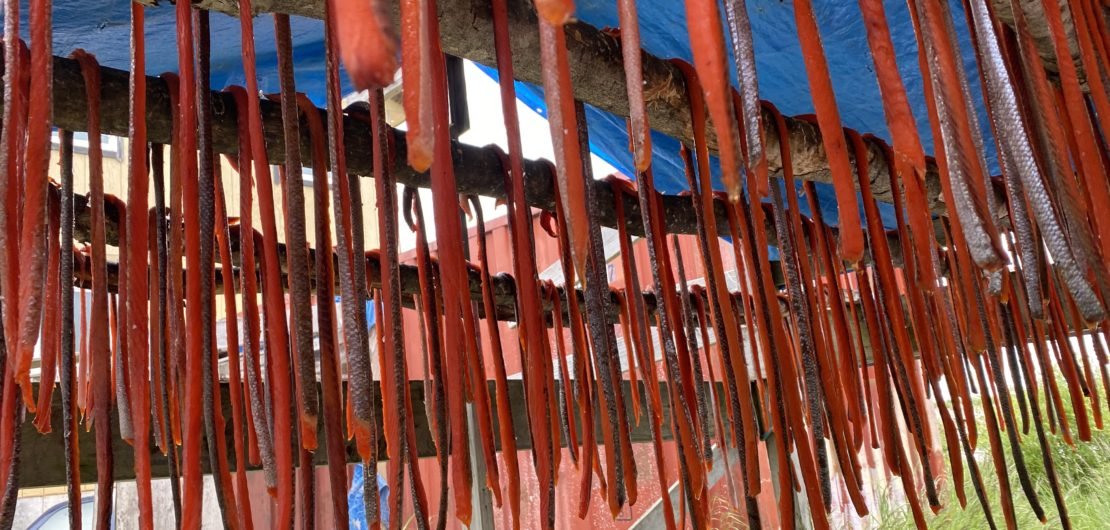New reports show crisis; trawlers catch and discard Yukon, Kuskokwim Chinook and chum salmon while smokehouses empty
Photo by: Diane McEachern
A number of salmon runs throughout Alaska are at unprecedented lows. Catastrophic failures and fisheries closures threaten fisheries-dependent communities, food security, culture and way of life as council governing bycatch prepares to meet in Sitka
JUNEAU, AK: New reports on trawl bycatch and salmon stocks just released by the Alaska Department of Fish & Game (ADF&G) and the National Oceanic and Atmospheric Administration (NOAA) paint a devastating picture of how while subsistence fisheries on the Yukon and Kuskokwim Rivers have seen closures due to low runs, the pollock trawl fleet continues to catch and discard a significant number of Chinook and chum salmon originating in those river systems. Meanwhile, NOAA Fisheries Assistant Administrator Janet Coit heads to Sitka, Alaska for a North Pacific Fishery Management Council (NPFMC) meeting that begins Monday, June 6.
The ADF&G stock status report released at the end of May determined:
Western Alaska Chinook salmon runs in 2020 and 2021 were the poorest observed over the past 40 years[1].
Western Alaska chum salmon decline was even more extreme in 2021 than 2020. The 2021 run was by far the smallest ever documented, at one-third the size of the previous record poor abundance, in 2000. In most of Western Alaska, 2020 and 2021 chum salmon runs were the lowest on record. In 2021, both Yukon River summer and fall chum salmon runs were lower than at any other point since 1981, with a combined fall and summer chum salmon run size under 250,000 fish.
ADF&G has announced subsistence and sportfish closures in these regions due to poor returns.
On May 31, 2022 ADF&G announced that on the Yukon River, due to low forecasted runs, “subsistence salmon fishing is being closed to protect Chinook and summer chum salmon as they begin to migrate upriver.”[2]
On May 1, 2022, ADF&G closed sport fishing for Chinook salmon in the Kuskokwim River due to a run forecast that mirrors 2021’s run, when the subsistence fishery was closed.[3]
NOAA’s genetics studies of 2020 and 2021 trawl salmon bycatch released at the end of May determined:
52% of Chinook bycatch from the Bering Sea Aleutian Islands pollock trawl fishery in 2020, an estimated 16,796 fish, originated in Coastal Western Alaska.[4]
In 2020, “the number of [Chinook salmon] caught from the Coastal Western Alaska stock was substantially higher than the 10-year average and represented the second highest catch in the last decade.”
The 2020 Bering Sea Aleutian Islands pollock trawl caught 546,043 chum salmon as bycatch, the second highest total since 1991.[5]
The Bering Sea Aleutian Islands pollock trawl fishery caught 51,510 chum salmon that originated in Western Alaska and the Upper/Middle Yukon in 2021.
“NOAA and the trawl fleet love to focus on the percentage of the salmon bycatch that originates in Alaska because it hides the actual massive number of wasted individual fish, which dwarfs the number allowed to be harvested by traditional users on the Yukon and Kuskokwim,” said Lindsey Bloom, a commercial fisherman and campaign strategist at SalmonState. “Local people who depend on these fish for physical, spiritual, and cultural survival are restricted again this year from taking a single salmon, while factory trawlers are allowed to kill tens of thousands from those same rivers. The federal and state management bodies are obligated to sustain the continued existence of salmon and our salmon fisheries, and we are begging them to act.”
“Right now, NOAA Fisheries Administrator Janet Coit is preparing to head to Sitka for a meeting of the North Pacific Fishery Management Council, an entity that has been largely deaf to Alaskans’ repeated pleas for reductions in trawl bycatch,” said Tim Bristol, executive director of SalmonState. “The burden of conservation is falling on subsistence and commercial salmon fishermen, while factory trawlers continue to bycatch and discard tens of thousands of Chinook and chum salmon originating in those same river systems. The message from these reports to Assistant Administrator Coit and the council should be clear: the time for action is now, and the very future of our wild Chinook and chum salmon is at stake.”
The NPFMC meeting begins Monday, June 6, with salmon items planned for discussion June 12 and 13. The full meeting schedule is here.
[1]https://meetings.npfmc.org/CommentReview/DownloadFile?p=7bb8ba14-30b7-440f-8d79-57ebf95c5ca9.pdf&fileName=D1a%20ADFG%20WAK%20Chinook%20and%20chum%20stock%20status%20update.pdf
[2] http://www.adfg.alaska.gov/static/applications/dcfnewsrelease/1376182623.pdf
[3] https://www.adfg.alaska.gov/Static-sf/EONR/PDFs/2022/R3/EO-3-KS-V-02-22%20KGMA.pdf
[4]https://meetings.npfmc.org/CommentReview/DownloadFile?p=37b35241-12f0-4343-82bd-0c6c72e5c136.pdf&fileName=D1b%20Bering%20Sea%20Chinook%20Genetics%20Report%202020.pdf
[5]https://meetings.npfmc.org/CommentReview/DownloadFile?p=247bfc4c-d7cd-4030-82ef-db503fbcb342.pdf&fileName=D1b%20BS%20Chum%20Salmon%20Bycatch%20Genetics%20Report%202021.pdf

